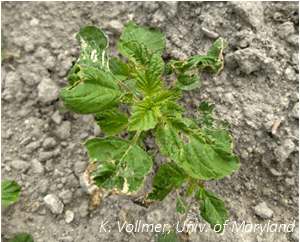Kurt Vollmer, Dwayne Joseph, and Alan Leslie
University of Maryland

Starting clean or weed-free is the key to a good weed control program, especially when noxious weeds, such as Palmer amaranth are present. While conventional growers can use soil-active herbicides to manage these weeds, control is more complicated in organic systems. Flame weeding is a non-chemical tactic that has been shown to control several grass and broadleaf weed species. The majority of flame weeding treatments are applied to emerged weeds; however, studies have also shown flame treatments to have detrimental effects on the seeds of certain weed species post-dispersal. Furthermore, seeds from species such as horseweed (marestail) and Palmer amaranth tend to germinate from shallower depths in the soil profile, and may be more readily controlled by flaming on or near the soil surface. Cultivation/tillage is another tactic that can be used to control weeds in both conventional and organic systems. However, cultivation can lead to additional weed emergence and cannot be used when the soil is wet. Flame weeding may help to supplement weed control when cultivation is not an option.
In 2023, a study funded by the Maryland Soybean Board was conducted at sites in Caroline and Kent county Maryland to evaluate flame-weeding as an integrated tactic for early-season weed control in soybean (Table 1). All plots were flamed immediately after planting followed by 1 or 2 additional flame treatments or flame treatments integrated with a cultivation treatment when weeds reached 3” in height. In addition, different walking speeds (1 and 2 mph) were tested to determine if longer flame exposure improved weed control. All flame treatments were made using a propane-powered Inferno Flame Weeder (Neversink Farms, Figure 1), and cultivation was done using a 25cc 2-cycle gas-powered cultivator (Craftsman).
Table 1. Integrated flame-weeding treatments.
| Treatment No. | Treatment | Speed
(mph) |
| 1 | Flame at planting | 1 |
| 2 | Flame at planting fb* flame 3” weeds | 1 |
| 3 | Flame at planting fb flame 3” weeds fb flame 3” weeds | 1 |
| 4 | Flame at planting fb cultivation 3” weeds fb flame 3” weeds | 1 |
| 5 | Flame at planting fb cultivation 3” weeds | 1 |
| 6 | Flame at planting | 2 |
| 7 | Flame at planting fb flame 3” weeds | 2 |
| 8 | Flame at planting fb flame 3” weeds fb flame 3” weeds | 2 |
| 9 | Flame at planting fb cultivation 3” weeds fb flame 3” weeds | 2 |
| 10 | Flame at planting fb cultivation 3” weeds | 2 |
| *fb= followed by | ||
Results from both studies showed that flame treatments affected overall broadleaf density, but cultivation was needed to attain higher levels of control. Flame treatments alone helped to reduce weed density at the Kent County study relative to the untreated check, with three subsequent flame treatments showing a reduction in broadleaf weed density compared to one or two flame treatments (Figure 2).

While a diversity of species were present at the Kent County site, Palmer amaranth was the dominant species at the Caroline County site. At this site both treatment and walking speed had an effect on Palmer amaranth density 4 weeks after planting. While the majority of flame treatments did not differ from one another, Palmer amaranth density was lower with 3 subsequent flame treatments at 1 mph compared 3 subsequent flame treatments at 2 mph (Figure 3). Similar results were observed with the flame followed by cultivation followed by flame treatment suggesting that longer flame exposure may be needed for effective Palmer amaranth control. It should also be noted that Palmer amaranth varied in height at the time of postemergence applications, with flame treatments having a reduced effect on larger weeds (Figure 4).

While results from both sites showed that flame treatments can reduce weed density, weed control was not maintained at acceptable levels throughout the growing season. In the case of the Caroline County site, the level of the Palmer amaranth infestation was too high to produce a viable crop. These results suggest that preemergence flame treatments are not a viable option for weed management compared to postemergence flame treatments. However, additional research is needed to determine how postemergence flame treatments may be better integrated into a more comprehensive weed control program.
